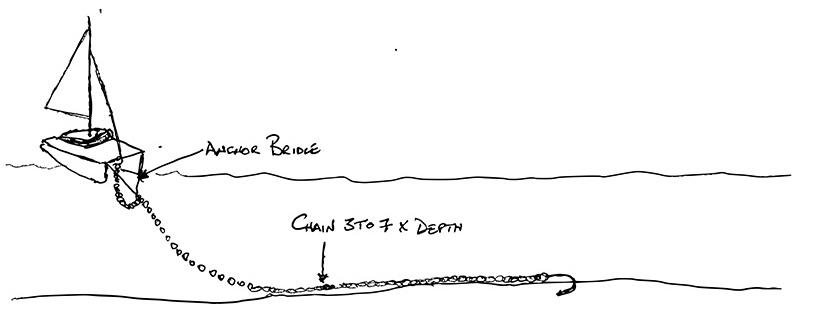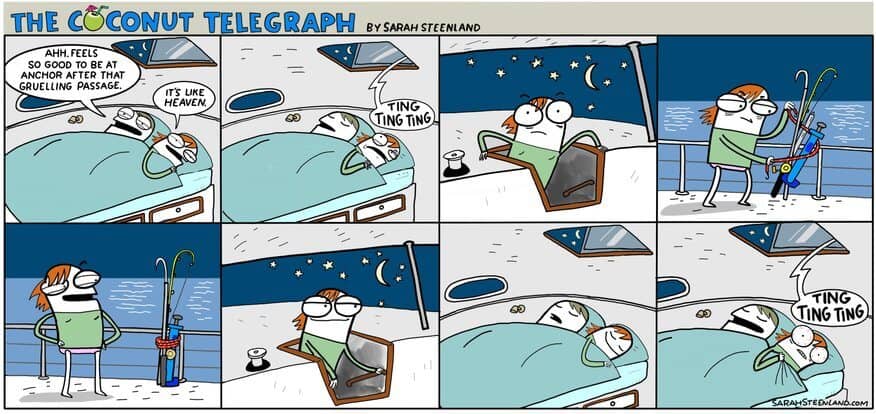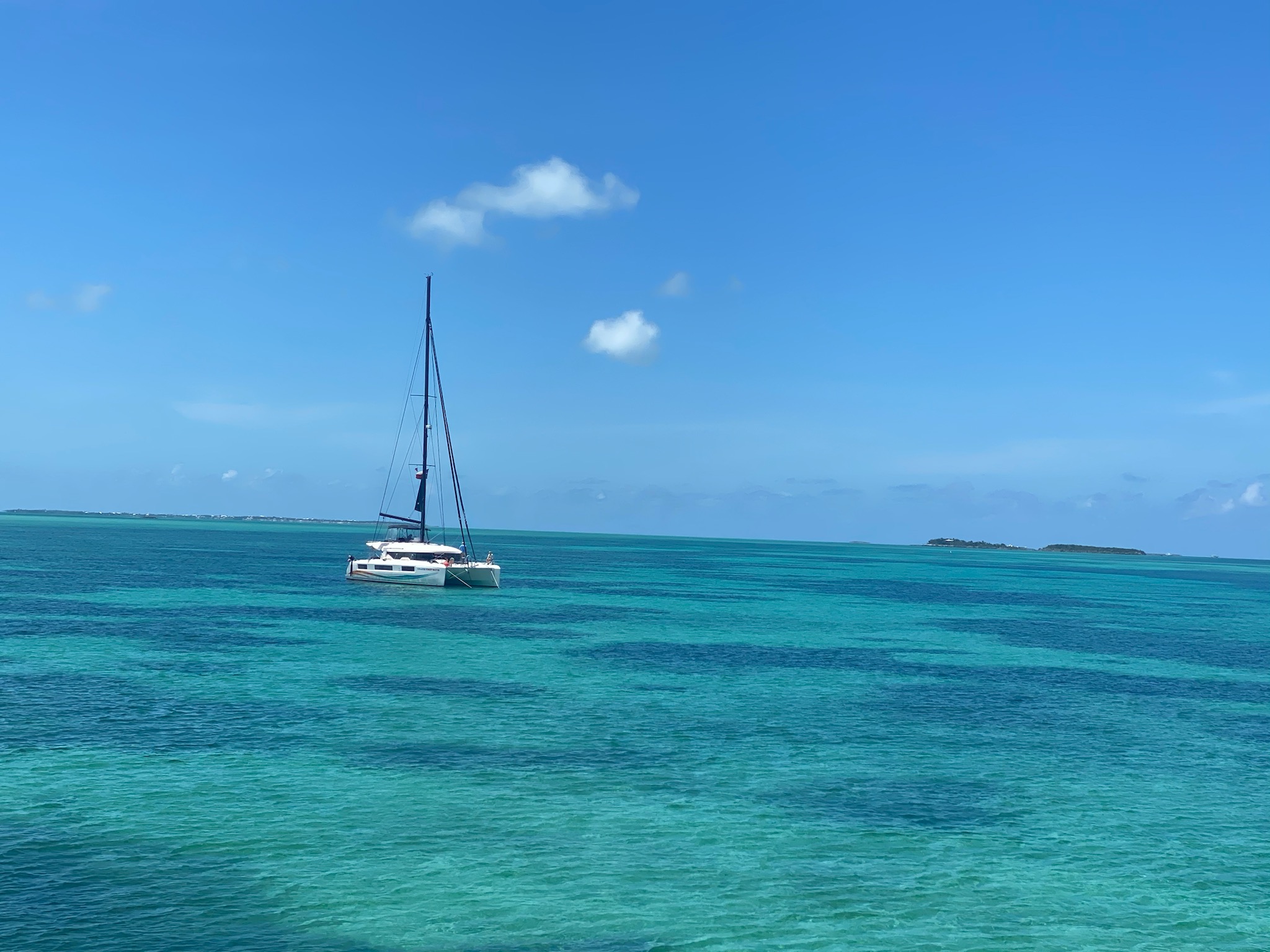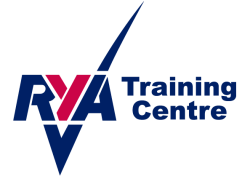The key to good anchoring is preparation and slow maneuvering. If the anchor does not set, just go around and restart the maneuver. There is no shame in starting again!

TIP: If you need to do a second go around make sure the anchor is not dragging in the water as it can damage the bow. Pull it up snug to the bow roller so that it is ready to be deployed again.
Try to arrive at your anchorage relatively early, with enough light to locate potential reefs and other hazards. Besides, if you get somewhere too late, and for some reason you cannot anchor (no room left for example), you need to have extra time to go somewhere else before nightfall.
Prepare Your Crew With Hand Signaling
Arrange a set of simple hand signals with the crewmember who will be at the bow to operate the anchor. They save a lot of aggravation and add to your safety. Here is a suggested set of hand signals. Alternately, use a headset but we have found that hand signals work much better.
|
Survey Anchorage & Prepare Anchoring Gear
- Unless you are a master sailor, always anchor under power.
- At this stage, all sails should be furled tight.
- Once you are at the location, take a tour of the anchorage at very slow speed to:
- Get a sense of where you would like to be for the night.
- Spot the sandy areas where your holding will be best. If possible avoid grassy areas where it is very difficult to set an anchor.
- Avoid rolly spots, if possible.
- Shorten the dinghy painter all the way, to keep the painter from becoming entangled in the propeller. This does happen!
- The anchor and the chain should be clear and the anchor ready to be dropped, slightly disengaged from the bow rollers.
- Check the depths and decide how much chain and/or rode to let out.
TIP: Recommended Lengths For Chain or Rode
If you only have chain, your scope ratio is at least 5 to 1 (example: if depth is 20 ft + 5 ft from roller to the water, let 125 ft. of chain out. More in strong winds.) If you have chain and rope, your ratio is 7 to 1. Note: it is not the depth where the boat lays, which can be much greater or less, it is where the anchor is that determines the scope calculation.
TIP: Anchor In A Similar Fashion as the Boat Next To You
In a crowded anchorage, always anchor in a similar fashion as the boat next to you or the two boats may drift into each other. For example: If your boat is fixed in place with two anchors and the other boat has a single anchor, the other boat may be blown into your boat. In addition, look at the other boats in the anchorage and take note of the type and the angle of their ropes to the water. This will help you judge the amount of rode let out and give an idea of the swing radius of the other boats. Remember if a boat has an all chain rode, it may have a 5:1 or less scope and have a smaller swinging radius than a boat with a combination chain and rope line. Boats that are anchored next to each other that have a different swing radius are also at greater risk to drift into each other if the current or wind changes, as this diagram above shows.*US Powerboating
 TIP: Characteristics Of Good Anchorage
TIP: Characteristics Of Good Anchorage
- Protected from wind and waves
- Enough depth and space to swing
- Good holding e.g. sand, clay
Anchoring Maneuver
Once you spot the location where you would like to anchor
- Make sure you will have enough room to swing without hitting any other boat.
- If you are far from any other boat, approach facing the wind at very slow speed and simply drop your anchor where you want it set.
- If you’re anchoring among other boats, a good strategy is to anchor astern of a boat that has space behind it. The idea is to get relatively close, drop the anchor and fall back. This way even if the wind changes 180 degrees you will not hit each other and you can never be above each others anchors. If the situation is tighter and you find a space behind two anchored boats then the maneuver is to position yourself abeam between the two boats, drop your anchor and fall back so you are behind them off their aft quarters. If you have to anchor ahead of another boat be sure that you go far enough forwards before dropping your anchor so that when you fall back you are not on top of the boat behind you, this is a judgement call. Assuming all boats are doing this, the anchoring configuration will be staggered ensuring no boat will hit another when swinging.
- Let the anchor down steadily and start backing up slowly at the same time. At this point, the anchor man should let about 2/3 of the desired length out. Now just let boat sit and settle for a few minutes. Then with the anchor man still at the bow, start backing up the boat gently to lay down the rest of the chains desired length. Let the boat settle again. Then put the engine in idle reverse position. The bow crew rests one foot lightly on the chain between the windlass and the bow roller. This accomplishes 2 things:
- You’re making sure the chain does not “jump”, which would mean the anchor is not set. If this is the case, you will feel the chain literally jumping under your foot. Let more chain out until the chain remains taut under your foot when backing up.
- If the anchor sets, backing up the boat really “digs” the anchor deeper. Complete the digging process by gradually revving up the engine in reverse for about 30 sec. To visually check if the boat is dragging put the engine/s into astern in idle to tension the chain and then either take a safety bearing on an object on the shore that you can easily identify (it is good to be able to see it at night as well). Another method is to select a set of transits (Poles, trees buildings land marks or a combination of them). If your bearing changes while you are pulling on the chain you are dragging. If you have chosen a set of transits then you need to watch and see if they change position relative to each other, if there is a change you are dragging. If the bearing remains static or the transits remain static then you are well anchored and the anchor is set, you can cut off your engine.
- If the anchor is NOT set, restart restart the entire process until you’re satisfied.
TIP: Immediate Action Drill When Your Anchor Drags
Let out more scope to reset the anchor. If this is unsuccessful then retrieve the anchor and re-anchor – hoping that it will eventually set is a bad strategy! Hope is not a strategy and you will drag at the worst possible time if you are not properly hooked.
- If possible take your snorkel, mask and fins and go swim over the anchor to visually check that it is properly dug in the sand. This is very important. We all have seen countless people arrive at an anchorage, drop the hook with a few feet of chain or rode, and…that’s it, the party starts. This is a disaster waiting to happen.
- Once you feel comfortable with everything you’ve done, take the final step and set up a snubber line. Your boat should have one set up and ready to use, this is really important.
- Lastly, for the next hour, and then periodically after that, visually check that the boat is not dragging by checking your safety bearing or transits ashore to verify you are not moving.
TIP: Things to Avoid While Anchoring
- Exposure to a lee shore
- Areas open to a broad fetch
- Proximity to mooring fields and channels
- Sloping or grassy bottoms
- Boats that swing differently from yours
- Rowdy or careless neighbors
- Anchoring up wind of another vessel (so you end up over their anchor
TIP: When in Doubt, Let It Out!
 If it is extremely windy or you are expecting squalls or a storm during the night let out more scope. If you are not sure if you have enough scope out then let more out. You cannot have too much scope out unless you are in danger of hitting other boats, you can certainly have too little scope out.
If it is extremely windy or you are expecting squalls or a storm during the night let out more scope. If you are not sure if you have enough scope out then let more out. You cannot have too much scope out unless you are in danger of hitting other boats, you can certainly have too little scope out.
The entire process above (providing you do not have to reset the anchor) takes about 20 minutes, and is simply a matter of being methodical and calm, anchoring is a very important technique to master.
TIP: Most situations you are likely to encounter while cruising can be handled with a single anchor. The 2-anchor set up is more complicated, can be a pain if you have to leave quickly, and, again, is rarely justified, providing you are properly applying the above technique.
Here is a great video to demonstrate good anchoring technique
Anchoring A Catamaran
 Because a cat offers less resistance to the water and is lighter than a similar size monohull (no lead ballast) it takes less time to slow down than a monohull. Keep the boat straight into the wind using the engines, do not let the boat go sideways. As soon as the anchor is set, back the boat straight down with both engines.
Because a cat offers less resistance to the water and is lighter than a similar size monohull (no lead ballast) it takes less time to slow down than a monohull. Keep the boat straight into the wind using the engines, do not let the boat go sideways. As soon as the anchor is set, back the boat straight down with both engines.
You need to set the snubber with the bridle that all cats are equipped with. Keep the boat into the wind as you’re doing this. Always use a bridle and never cleat off to just one hull. Catamarans tend to sit better at anchor than monohulls. The reason is that the bridle holds the bows into the wind at all times. (On a monohull the bow acts as a sail and in strong winds the boat tends to sail at anchor. There is not too much that can be done but a double snubber often helps aleviate the problem).
Weighing Anchor
- Start your engine, the windlass has a huge power draw and the alternator needs to be charging the batteries to avoid damaging them. The person on the bow and the person at the helm should have a set of hand signals that they understand to communicate with each other while performing this operation
- Using hand signals, instruct the helmsman to move the boat forward very slowly in the direction of the chain using the engine. Make sure you have the helmsman stop the motion before you overshoot the anchor.
- Start cranking the chain up while it is slack. When you get to the snubber line, stop cranking and simply remove it. Then resume cranking. When the chain starts getting taut again, instruct the helmsman to move the boat forward with the engine. The whole idea here is to avoid using the windlass to move the boat forward, as this causes unnecessary strain on the windlass shaft and on the chain roller.
TIP: Rule of thumb: the engine is to move the boat forwards and the windlass is to lift the chain and anchor from the sea bed
- At one point you will find the boat straight above the anchor with the chain taut. Do NOT use the windlass to break the anchor free, signal the helmsman to slowly “drive over” the anchor and by using the engine and the weight of the boat, the shank of the anchor will lift and break the anchor free. Once free, finish cranking the chain up all the way until the anchor settles on the bow roller and secure it.
- Signal the helmsman that the boat is free and get back to the cockpit, you’re done.
General Cruising Tips
- When anchored and you go ashore, always take a flashlight and switch the anchor light on even if it is midday. You never know when you will return and your boat will be much easier to find in the dark.
- Always secure the dinghy properly, if you have davits lift it. This is your main form of transport and should be protected.
- If you have visitors to your boat in the anchorage ALWAYS make them secure their own dinghy, if it gets loose or lost, it is not your responsibility – has happened to me!
- Always approach a yacht with a dinghy from downwind and come alongside on starboard if visiting another yacht.
Sail With Us to Learn


Week-Long Liveaboard Courses
Rare RYA Classes & Certifications
Catamaran Guru’s real-life practical methods combined with up-to-date sailing theory in lessons aboard recent model catamarans…or your own boat!
Prepare for certifications or take the first step aboard to embark on your dream life of boat ownership or cruising
Classes in S Florida and the Bahamas.





